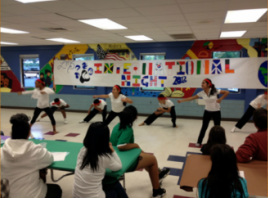1.1 Knowledge of learners and learning
Candidates base twenty-first century skills instruction on student interests and learning needs and link it to the assessment of student achievement.
2010 ALA/AASL Standards for Initial Preparation of School Librarians
|
“That is part of the beauty of all literature. You discover that your longings are universal longings, that you're not lonely and isolated from anyone. You belong.” -- F. Scott Fitzgerald
Students need to see themselves in literature, or they will not connect to reading. In Instructional Collaboration, SLM 509, this collaborative unit plan and two sample lessons between the librarian and English language arts teacher facilitates students’ exploration of culture. Students will be able to create a multimedia presentation that explores the connection between primary sources on culture and a theme revealed while reading Cuba 15 by Nancy Osa. Students will draw from databases and print resources to create the presentation, which will be presented to the community during International Night. Over this two-week plan, students discover how to form research questions and are exposed to the subscription databases and Web2.0 presentation tools. Students research their own cultural background as they explore the theme of the novel. This ties their learning to their interests, engaging students in the content. |
 Photograph by Pam Altman 2012
Photograph by Pam Altman 2012
Student’s interests are limited in scope by their life experiences. Whenever you can directly tie a lesson to have them critically consider their own experience and then expand into the targeted objective, learning and growth occurs. In addition to the critical thinking and research skills, another strength of this lesson is the collaboration between teacher and librarian. The librarian brings the expertise in research and technology; the language arts teacher brings the expertise in literary analysis. At the International Night community event, the students will teach all about culture and its influence on their lives. Having a topic that connected directly to students’ lives was an excellent way to frame a lesson on asking research questions. Learning how to ask the correct questions will equip students with lifelong learning skills for any future topic. Linking the assessment to an authentic community presentation creates student buy-in and persistence. It is an ambitious project; two weeks is a long time to spend in the media center with one class, but is worth the effort.
I will reuse this lesson, adapting it to novels within different grade-level curricula. I believe it can even be adapted to lower elementary by scaling down the research questions and using picture books and easy readers. When I am the school library media specialist I will be attending team-planning meetings, I am eager and excited to adapt this lesson to their needs and objectives and try it out with students. I feel it is important to display inquiry-based learning to the community at school events and give students the authentic opportunity to share their perspective and new ideas in a “real-world” setting.
I will reuse this lesson, adapting it to novels within different grade-level curricula. I believe it can even be adapted to lower elementary by scaling down the research questions and using picture books and easy readers. When I am the school library media specialist I will be attending team-planning meetings, I am eager and excited to adapt this lesson to their needs and objectives and try it out with students. I feel it is important to display inquiry-based learning to the community at school events and give students the authentic opportunity to share their perspective and new ideas in a “real-world” setting.
 This portfolio and the artifacts contained herein by Amy Soldavini are licensed under a Creative Commons Attribution-NonCommercial-ShareAlike 3.0 Unported License. |
Revised July 2013
